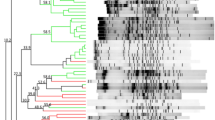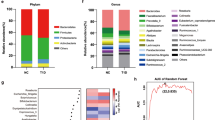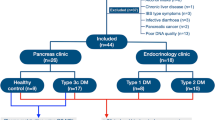Abstract
Several studies have shown that gut bacteria have a role in diabetes in murine models. Specific bacteria have been correlated with the onset of diabetes in a rat model. However, it is unknown whether human intestinal microbes have a role in the development of autoimmunity that often leads to type 1 diabetes (T1D), an autoimmune disorder in which insulin-secreting pancreatic islet cells are destroyed. High-throughput, culture-independent approaches identified bacteria that correlate with the development of T1D-associated autoimmunity in young children who are at high genetic risk for this disorder. The level of bacterial diversity diminishes overtime in these autoimmune subjects relative to that of age-matched, genotype-matched, nonautoimmune individuals. A single species, Bacteroides ovatus, comprised nearly 24% of the total increase in the phylum Bacteroidetes in cases compared with controls. Conversely, another species in controls, represented by the human firmicute strain CO19, represented nearly 20% of the increase in Firmicutes compared with cases overtime. Three lines of evidence are presented that support the notion that, as healthy infants approach the toddler stage, their microbiomes become healthier and more stable, whereas, children who are destined for autoimmunity develop a microbiome that is less diverse and stable. Hence, the autoimmune microbiome for T1D may be distinctly different from that found in healthy children. These data also suggest bacterial markers for the early diagnosis of T1D. In addition, bacteria that negatively correlated with the autoimmune state may prove to be useful in the prevention of autoimmunity development in high-risk children.
Similar content being viewed by others
Log in or create a free account to read this content
Gain free access to this article, as well as selected content from this journal and more on nature.com
or
Accession codes
References
Allison SD, Martiny JBH . (2009). Resistance, resilience, and redundancy in microbial communities. Proc Natl Acad Sci USA 105: 11512–11519.
Armougom F, Henry M, Vialettes B, Raccah D, Raoult D . (2009). Monitoring bacterial community of human gut microbiota reveals an increase in Lactobacillus in obese patients and Methanogens in anorexic patients. PLOS One 4: e7125.
Brugman S, Klatter FA, Visser JTJ, Wildeboer-Veloo ACM, Harmsen HJM, Rozing J et al. (2006). Antibiotic treatment partially protects against type 1 diabetes in the Bio-Breeding diabetes-prone rat. Is the gut flora involved in the development of type 1 diabetes? Diabetologia 49: 2105–2108.
Calcinaro F, Dionisi S, Marinaro M, Candeloro P, Bonato V, Marzotti S et al. (2005). Oral probiotic administration induces interleukin-10 production and prevents spontaneous autoimmune diabetes in the non-obese diabetic mouse. Diabetologia 48: 1565–1575.
de Kruif P . (1926). Microbe Hunters. Harcourt, Brace and Co.: New York.
Edgar RC . (2004). MUSCLE: a multiple sequence alignment method with reduced time and space complexity. Bioinformatics 5: 1–19.
Favier CF, Vaughan EE, De Vos WM, Akkermans ADL . (2002). Molecular monitoring of succession of bacterial communities in human neonates. Appl Environ Microb 68: 219–226.
Frank DN, St Amand AL, Feldman RA, Boedeker EC, Harpaz N, Pace NR et al. (2007). Molecular-phylogenetic characterization of microbial community imbalance in human inflammatory bowel diseases. Proc Natl Acad Sci USA 104: 13780–13785.
Giongo A, Crabb DB, Davis-Richardson AG, Chauliac D, Mobberley JM, Gano KA et al. (2010a). PANGEA: pipeline for analysis of next generation amplicons. ISME J 4: 852–861.
Giongo A, Davis-Richardson AG, Crabb DB, Triplett EW . (2010b). TaxCollector: tools to modify existing 16S rRNA databases for the rapid classification at six taxonomic levels. Submitted.
Harrison LC, Honeyman MC, Morahan G, Wentworth JM, Elkassaby S, Colman PG et al. (2008). Type 1 diabetes: lessons for other autoimmune diseases? J Autoimmun 31: 306–310.
Hayashi H, Sakamoto M, Benno Y . (2002). Phylogenetic analysis of the human gut microbiota using 16S rDNA clone libraries and strictly anaerobic culture-based methods. Microbiol Immunol 46: 535–548.
Kupila A, Muona P, Simell T, Arvilommi P, Savolainen H, Hamalainen AM et al. (2001). Feasibility of genetic and immunological prediction of Type I diabetes in a population-based birth cohort. Diabetologia 44: 290–297.
Larsen N, Vogensen FK, van den Beg FWL, Nielsen DS, Andreasen AS, Pedersen BK et al. (2010). Gut microbiota in human adults with type 2 diabetes differs from non-diabetic adults. PLoS One 5: e9085.
Lechevalier HA, Solotorovsky M . (1974). Three Centuries of Microbiology. Dover Publications: New York.
Li W, Godzik A . (2006). CD-HIT: a fast program for clustering and comparing large sets of protein or nucleotide sequences. Bioinformatics 22: 1658–1659.
Lozupone C, Hamady M, Knight R . (2006). UniFrac—An online tool for comparing microbial community diversity in a phylogenetic context. BMC Bioinformatics 7: 371.
Manichanh C, Rigottier-Gois L, Bonnaud E, Gloux J, Pelletier E, Frangeul L et al. (2006). Reduced diversity of faecal microbiota in Crohn's disease revealed by a metagenomic approach. Gut 55: 205–211.
Matsuzaki T, Nagata Y, Kado S, Uchida K, Kato I, Hashimoto S et al. (1997). Prevention of onset in an insulin-dependent diabetes mellitus model, NOD mice, by oral feeding of Lactobacillus casei. APMIS 105: 643–649.
Nejentsev S, Sjoroos M, Soukka T, Knip M, Simell O, Lovgren T et al. (1999). Population-based genetic screening for the estimation of Type 1 diabetes mellitus risk in Finland: selective genotyping of markers in the HLA-DQB1, HLA-DQA1 and HLA-DRB1 loci. Diabetic Med 16: 985–992.
Roesch RFW, Casella G, Simell O, Krischer J, Wasserfall CH, Schatz D et al. (2009a). Influence of sample storage on bacterial community diversity in fecal samples. Open Microbiol J 3: 40–46.
Roesch RFW, Lorca GL, Casella G, Giongo A, Naranjo A, Pionzo AM et al. (2009b). Culture-independent identification of gut bacteria correlated with the onset of diabetes in a rat model. ISME J 3: 536–548.
Sapp J . (2009). The new foundations of evolution: on the tree of life. Oxford University Press: New York.
Sartor RB . (2008). Microbial influences in inflammatory bowel diseases. Gastroenterology 134: 577–594.
Schwartz RF, Neu J, Schatz D, Atkinson MA, Wasserfall C . (2007). Comment on: Brugman S et al. (2006). Antibiotic treatment partially protects against type 1 diabetes in the Bio-Breeding diabetes-prone rat. Is the gut flora involved in the development of type 1 diabetes? Diabetologia 49:2105-2108. Diabetologia 50: 220–221.
Shannon CE, Weaver W . (1949). The mathematical theory of communication. Urbana IL: University of Illinois Press.
Tiihonen K, Ouwehand AC, Rautonen N . (2009). Human intestinal microbiota and healthy ageing. Ageing Res Rev 9: 107–116.
The TEDDY Study Group (2007). The Environmental Determinants of Diabetes in the Young (TEDDY) study: study design. Pediatr Diabetes 8: 286–298.
Turnbaugh PJ, Ley RE, Mahowald MA, Magrini V, Mardis ER, Gordon JI . (2006). An obesity-associated gut microbiome with increased capacity for energy harvest. Nature 444: 1027–1031.
Turnbaugh PJ, Hamady M, Yatsunenko T, Cantarel BL, Duncan A, Ley RE et al. (2009). A core gut microbiome in obese and lean twins. Nature 457: 480–485.
Vaarala O, Atkinson MA, Neu J . (2008). The ‘Perfect Storm’ for type 1 diabetes. The complex interplay between intestinal microbiota, gut permeability, and mucosal immunity. Diabetes 57: 2555–2562.
Valladares R, Sankar D, Li N, Williams E, Mahmou ASA, Lai K-K et al. (2010). Lactobacillus johnsonii N6.2 mitigates the development of type 1 diabetes in BB-DP rats. PLoS One 5: e10507.
Wen L, Ley RE, Volchkov PY, Stranges PB, Avanesyan L, Stonebraker AC et al. (2008). Innate immunity and intestinal microbiota in the development of Type 1 diabetes. Nature 455: 1109–1113.
Willing B, Halfvarson J, Dicksved J, Rosenquist M, Jarnerot G, Engstrand L et al. (2009). Twin studies reveal specific imbalances in the mucosa-associated microbiota of patients with ileal Crohn's disease. Inflamm Bowel Dis 15: 653–660.
Yadav H, Jain S, Sinha PR . (2007). Antidiabetic effect of probiotic dahi containing Lactobacillus acidophilus and Lactobacillus casei in high fructose fed rats. Nutrition 23: 62–68.
Acknowledgements
This research was supported by the Florida Agricultural Experiment Station. We thank Professor Vassiliki Betty Smocovitis of the University of Florida for her advice on the history of microbiology.
Author information
Authors and Affiliations
Corresponding author
Additional information
Supplementary Information accompanies the paper on The ISME Journal website
Rights and permissions
About this article
Cite this article
Giongo, A., Gano, K., Crabb, D. et al. Toward defining the autoimmune microbiome for type 1 diabetes. ISME J 5, 82–91 (2011). https://doi.org/10.1038/ismej.2010.92
Received:
Revised:
Accepted:
Published:
Issue date:
DOI: https://doi.org/10.1038/ismej.2010.92
Keywords
This article is cited by
-
Gut Microbiota and Autoimmune Diseases: Mechanisms, Treatment, Challenges, and Future Recommendations
Current Clinical Microbiology Reports (2024)
-
Evaluating the effect of prebiotics on the gut microbiome profile and β cell function in youth with newly diagnosed type 1 diabetes: protocol of a pilot randomized controlled trial
Pilot and Feasibility Studies (2023)
-
Gut microbiome dysregulation drives bone damage in broiler tibial dyschondroplasia by disrupting glucose homeostasis
npj Biofilms and Microbiomes (2023)
-
Cystic Fibrosis-Related Gut Dysbiosis: A Systematic Review
Digestive Diseases and Sciences (2023)
-
Effect of crude polysaccharide from seaweed, Dictyopteris divaricata (CDDP) on gut microbiota restoration and anti-diabetic activity in streptozotocin (STZ)-induced T1DM mice
Gut Pathogens (2022)



